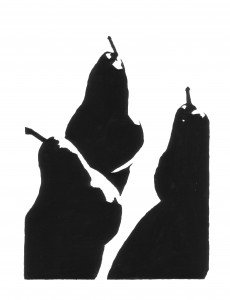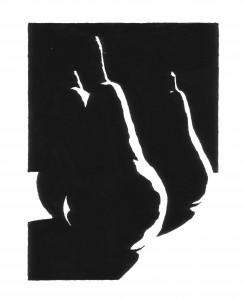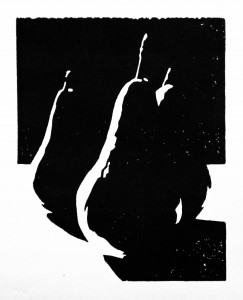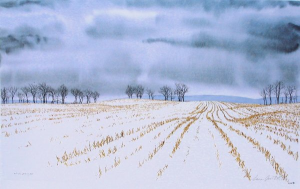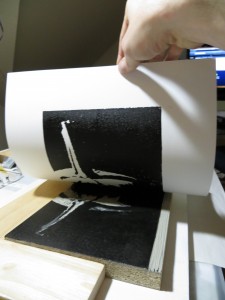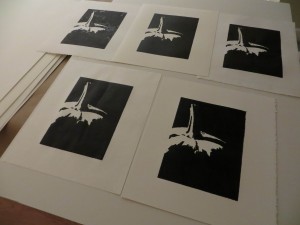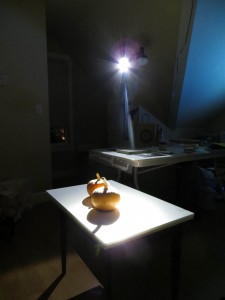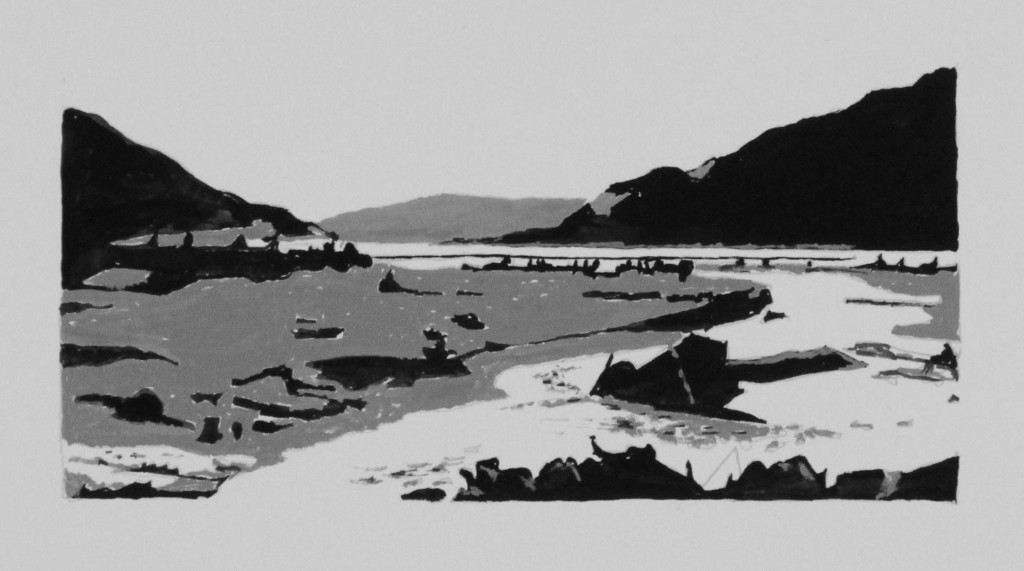Here’s another pear composition idea. It is amazing how few visual cues one actually needs to understand a scene.
Monthly Archives: November 2012
Pear Study Redux
Thanksgiving Linocuts
I’ve been having so much fun with the linocut prints that I pitched the idea as a family Thanksgiving activity. We all spent the afternoon listening to music, nibbling on appetizers and taking occasional breaks to carve our blocks and pull prints. I did this quick study of pears intended for a holiday card. The idea has promise, but I’m not really sold on the bits of light creeping around the right side of the middle and right pears. Next time I will do a gouache study before carving the block.
Printing notes: the proof below is actually on newsprint which performed better than the Daniel Smith Lennox paper. I went back and looked at my pumpkin print on Lennox and found that it suffered from the same problems I encountered with the pear – the ink sits high on the surface and it flows around, obscurring fine detail.
Susan Booth Titus
I love the negative space in this watercolor by Susan Booth Titus.
Dreaming of a White Christmas
This week we started to render white spheres in charcoal. The timing couldn’t have been better because Christmas ornaments just went on sale at Bartells. Christmas ornaments make excellent drawing spheres because:
- They are inexpensive and widely available. I got six for about $3.
- They come in a wide variety of sizes.
- They are very round and smooth. I recommend getting the frosted ones instead of the reflective ones because they hold paint better.
- They come with a hanging hook that is useful when applying spray paint.
Here are some painting tips:
- Use Killz Stain Blocking Primer in the spray can. This primer has a matte finish and is opaque enough to cover up any ornament color. If you have a transparent ornament, you will need at least two coats to prevent light from passing through and diluting the core shadows.
- Hang the ornament from a string.
- Wind the ornament up on the string and let it spin.
- Spray from a distance while the ornament spins. If you are careful, you can get a completely smooth coat.
- Leave ornament hanging by its string until it is dry.
Linocut Update
Today I experimented with papers designed specially for block printing and had much better success.
I used Dick Blick water soluble printing ink on five different papers. Here are the results:
- Masa Paper – excellent transfer, good detail, inexpensive
- Hosho Paper – good transfer, but very delicate – the ink began to soak through and I had to stop rubbing because the paper was disintegrating
- Canson Edition Bright White – good transfer, but ink sits on top of paper instead of soaking in.
- Rising Stonehenge – poor ink transfer, but I printed on the smooth side so I need to test again on the rough side.
- Daniel Smith Lennox – good transfer, but ink sits on top of paper instead of soaking in.
Overall, it seems that thinner papers with a nappy surface work the best.
Dramatic Shadows
People have asked me how I got the dramatic shadows in the pumpkin notans. The key was to use a very small, almost point source light at a distance and eliminate ambient room light. I used an LED headlamp about 6 feet away from the pumpkins. The LED headlamp is a great light source for chiaroscuro because it has only a single LED and it is pretty bright, even at a distance. By turning off the room lights, I was able to eliminate most ambient light and this intensified the blacks of the shadows.
I found the most successful arrangements where those where the subject was mostly backlit, with a bit of intense light peeking around the edge. Once the light is positioned, it helps to choose a background that contrasts with the lighting on the subject. I often used a split background with white to accentuate the edges in shadow and black to bring out the illuminated edges.
When working with dramatic lighting, the room tends to get pretty dark so you either need to work from photos or use one of those clip-on booklights on your drawing board.
First Linocut
The pumpkin notans were so successful I decided to reproduce them as linoleum block prints. I haven’t done this sort of a project since elementary school, but the block cutting went well. I pulled two test prints by hand using a baren and was pretty happy with the block, but still need to sort out the ink and paper combination so that I get solid blacks. My first print showed good detail, but the ink transfer was poor. I used a lot more ink on the second print and this helped the blacks, but I lost a bit of detail. Both prints were made with Dick Blick water soluble printing ink on Strathmore 300 Bristol Vellum. I’ve heard that oil based inks work better on cotton fiber papers, and that water soluble inks are better on Japanese rice papers. I also suspect that a thinner paper would take the ink better than the Bristol.
Classical Drawing Lesson Plans
Mandy Hallenius has put together some fantastic lesson plans for teaching classical drawing in a K-12 art classes. She currently has four lessons available for download. Check them out.

